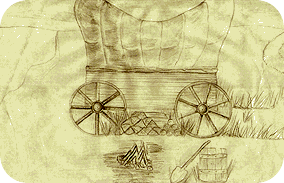Heritage Gateways
Official Sesquicentennial K-12 Education Projectsponsored by the Utah State Board of Education, the BYU-Public School Partnership and the Utah Education Network
Pioneer Date Summary
04/30/1847 - Crockett

Image courtesy of: Heritage Gateway Project Images, These images have been gathered to support the Sesquicentennial celebration of the immigration to Utah.
Location: Gibbon, Nebraska - Location: 40:44:54N 98:50:40W Elevation: 2060 feet
Date: April 30, 1847
On the Platte River, Nebraska:
The morning's journey started at 8:20 a.m. It was a chilly day,
with temperatures down into the low forties. William Clayton remarked, "About
a mile from where we camped last night, we passed a place where
the Indians have camped no doubt during their hunt. They must have
been very numerous for their camp has covered a number of acres
of ground."
After eight miles, the company nooned at a small creek with a gravel bottom, about a half mile from the river. They named it "Grass Creek." Horace Whitney wrote: "The grass here is of the highest and most luxuriant growth we have yet seen -- There have been three fresh buffalo tracks seen today by the hunter."
When they started again at 1:20 p.m., the wind was blowing very strong, and it felt quite cold. They traveled eight more miles and camped in a circle about two miles away from the river near a bluff without wood or water. The circle that was formed was "imperfect" because each wagon was faced such that the wind would be against it. It took more than an hour to form the camp. [The camp was located about five miles east of present-day Kearney, Nebraska. Not far from this site, on the south side of the river, the Oregon Trail converged with the Platte.]
For the first time they picked up dry buffalo dung (chips) which made a good fire. A well was dug and water was found. Thomas Bullock explained that holes were dug for the fires. "At Luke Johnson's fire I saw a Buffalo Skull made a chimney--the smoke coming out of two holes between the horns, combined the useful & ludicrous."
It was a cold evening. William Clayton wrote: "It is now so cold that every man wants his overcoat on and a buffalo robe over it. We have had no accident and the brethren felt well, some are wrestling to keep themselves warm." Brigham Young gave permission for the men to have a dance and to enjoy themselves because it was hard to stay warm. Brother Hansen provided the tunes on his violin. Many of the men had a difficult time sleeping because of the cold.
Winter Quarters, Nebraska:
Some of Peter Sarpy's teams came in from the Pawnee village, where
they had seen the pioneer company. William Kay helped move Mary Richards
into a house on the south picket line. This was the first house she
lived in since leaving Nauvoo a year earlier. During all that time,
she had lived in a tent. She wrote, "After I got to the house, I
got dinner and Bro[ther] K[ay] eat with us. After which I helped
cord the bedstead, move the bed, and regulated some of the things,
felt some tired."
Mormon Battalion, at Los Angeles, California:
Many of the men continued to work on the fort. David Pettigrew preached to the
men about the evils of drinking. Jefferson Hunt informed the men about some good
news. A sutler traveling with the New York Volunteers had just arrived with many
clothes for sale. General Kearny had sent word that these clothes could be purchased
at a reduced price. Since this was the end of the month, the battalion was mustered.
Company B, Mormon Battalion, at San Diego, California:
Robert S. Bliss recorded, "To day is our muster day according to Law which makes
the fifth must from the time entered the Service; We have to muster once more
to conclude the year & then we hope to go Speedily to our Familys & the Church."
Source: 150 Years Ago Today ©These materials have been created by David R. Crockett. Copies of these materials may be reproduced for teacher and classroom use. When distributing these materials, credit must be given to David R. Crockett. These materials may not be published, in whole or part, or in any other format, without the written permission of Mr. Crockett, Tucson Az, crockett@goodnet.com.Sources:
- Wilford Woodruff's Journal 3:163
- Bagley, ed., The Pioneer Camp of the Saints, 136-37
- Howard Egan Diary, Pioneering the West, 31
- "Excerpts from the hitherto unpublished Journal of Horace K. Whitney," Improvement Era, 50:204
- William Clayton's Journal, p.113-16
- Brooks, On the Mormon Frontier, The Diary of Hosea Stout, 1:253
- Ward, ed., Winter Quarters, The 1846-1848 Life Writings of Mary Haskin Parker Richards, 121
- Journal of Henry Standage in Frank Alfred Golder, The March of the Mormon Battalion, 220
- The Journal of Robert S. Bliss, The Utah Historical Quarterly, 4;92